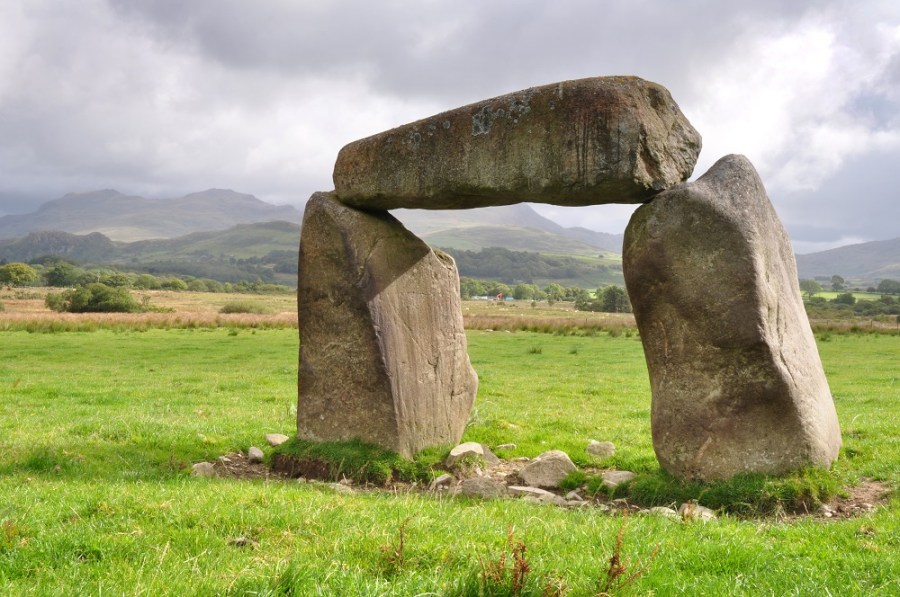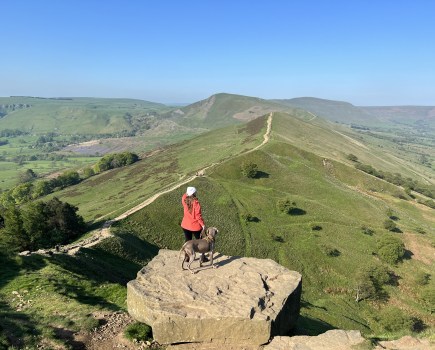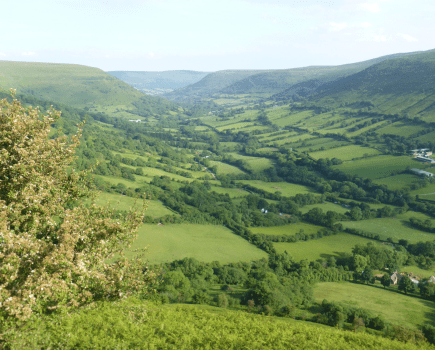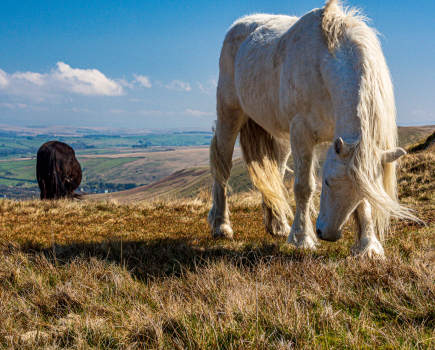Andrew Galloway goes in search of Owain Glyndŵr
Early one morning, the crystal waters of the Afon Dwyfor swollen from the rain of the previous night, we set out in search of Owain Glyndŵr. I had heard many times of the cave bearing his name, hidden somewhere on the flanks of Moel Yr Ogof, but on previous visits to this enigmatic mountain, the clag had hung thick to the valley slopes and I had not been able to locate it. As we climbed through Cwm Llefrith towards the ruined Moel Hebog mine, we speculated as to what we might find. Louise imagined us stumbling across the Cave of Caer Bannog wherein lives the dreaded and vicious killer bunny rabbit of Monty Python fame, whereas I saw us entering the mountain to discover the Grail Knight played by Robert Eddison in Indiana Jones and the Last Crusade, patiently waiting for hundreds of years for us to arrive, sword clasped in hand.
Although Wales is rich in Arthurian legend, Owain Glyndŵr was very much a political figure who orchestrated the last coordinated armed uprising against English rule in Wales at the end of the fourteenth century. His revolt was variously successful, more so in the north of the country than the south, but by 1408 the flame of Owain’s rebellion was beginning to fade. Owain made his escape from the English, but with the fall of these castles he effectively became an outlaw without refuge. The Welsh historian R. R. Davies has recorded the words of a chronicler of the time, who refers to Owain as being “a homeless fugitive, hiding in caves and in the mountain woods.”
After some searching Louise and I eventually discovered the cave, located precariously near the top of a steep gully and it took some nimble footwork to negotiate the traverse from the grass terrace above Bwlch Meillionen to reach its dark, damp coolness, beautifully lined with lush, green wood sorrel, club mosses and sundews. Much to our disappointment, no sleeping knight lay inside the cave’s verdant hide-away.
The gully above the cave opens to the boulder-strewn summit of Moel yr Ogof. We continued to Moel Lefn from where the suite of hills known collectively as the Nantlle Ridge stands as an undulating natural barrier to the north. Their brooding, alluring curves proved too much of a temptation, but in order to reach them we had to make a considerable descent via Bwlch Sais and negotiate the hazardous disused quarries of Cwm Trwsgl. The climb along the grassy spur which separates Cwm Dwyfor from Cwm Dû is an arduous one, but truly rewarding, as from the summit of Trum y Ddysgl the vista of the north Wales coast opens up, offering views over to Anglesey, Caernarfon and the Lleyn Peninsula.
The col between Trum y Ddysgl and Mynydd Tal-y-mignedd is precariously narrow though miraculously simple to negotiate and a brief climb led us to a stone obelisk situated at the summit. From this approach the serrated edge of Craig Pennant looks to be unassailable, but on closer inspection the ramparts are easily breached by means of a path that zigzags its way to the summit cairn, which marks the highest point along the ridge. Having crossed the elevated plateau that leads to the cairned summit of Carnedd-goch, we were faced with the problem of how to descend into Cwm Pennant. It is common in Eifionydd, a more remote region of rural Wales, for rights-of-way to disappear and indeed as we approached what was marked on our map as such to the south of Carnedd-goch, we could find no trace on the land. Instead we elected to follow the solid dry-stone wall bisecting the moorland to the sheepfolds and farm buildings at Bronmarlwyd, though this necessitated hacking through heather for some distance. Another hour of dogged determination was required to negotiate the old tracks and abandoned quarries of Cwm Pennant before we returned once again to the banks of the Afon Dwyfor.
The final resting place of Owain Glyndŵr remains unknown, but I like to think of him spending his last days amongst the calm and serenity of the mountains enclosing Cwm Pennant, reflecting on what might have been and perhaps, after many years of war, finally finding some peace.
Words and pictures: Andrew Galloway
Route description
Start/Finish: Cwm Pennant GR SH530465
- At a cattle grid look for footpath E. Cross river Dwyfor on stepping-stones, across meadows and across road. Continue E to reach the farm buildings at Cwrt Isaf.
- Continue along path to open moorland and follow the Afon Cwm-llefrith upstream.
- After crossing two large stone walls, continue to climb E to reach Bwlch Meillionen. Take steep path NW through the natural cleft in the rock. To find the cave of Owain Glyndŵr, traverse along the grass terrace that contours N around mountain until terrace narrows. Alternatively, continue NW to reach the summit of Moel yr Ogof.
- Continue NNW to Moel Lefn then zigzag down the steep slope to the N, past edge of forest and descend into Bwlch Cwm Trwsgl. Contour to the NW around Y Gyrn and passing through the upper levels of the Cwm-trwsgl quarry.
- Follow track NE to the fence at Bwlch-y-Ddwy-elor. Follow the fence NW up grassy spur, following the crest of the spur to the summit of Trum y Ddysgl after the fence descends into Cwm Du.
- Descend W and cross the narrow col, taking care, climb to stone obelisk on Mynydd Tal-y-mignedd. Descend SSW into Bwlch dros-bern then scramble behind Craig Pennant to arrive at the summit Cairn.
- Continue SW across plateau to cairned summit of Garnedd-goch. Follow the dry stone wall SW for 400m then SE along a transecting wall that, after 400m turns to the SSW.
- Continue along wall as a hand-rail for 2.5km. Where wall makes a right angle to the W, cross and continue S along right-of-way to sheep folds at Bronmarlwyd. Follow a path E along field boundaries to a more defined track. The track continues for 1.8km to the disused quarries at Chwarel y plas. Carefully descend through quarry, following track to the E to reach Plas y Pennant, then N along road to return to start.
Andrew Galloway goes in search of Owain Glyndŵr
Early one morning, the crystal waters of the Afon Dwyfor swollen from the rain of the previous night, we set out in search of Owain Glyndŵr. I had heard many times of the cave bearing his name, hidden somewhere on the flanks of Moel Yr Ogof, but on previous visits to this enigmatic mountain, the clag had hung thick to the valley slopes and I had not been able to locate it. As we climbed through Cwm Llefrith towards the ruined Moel Hebog mine, we speculated as to what we might find. Louise imagined us stumbling across the Cave of Caer Bannog wherein lives the dreaded and vicious killer bunny rabbit of Monty Python fame, whereas I saw us entering the mountain to discover the Grail Knight played by Robert Eddison in Indiana Jones and the Last Crusade, patiently waiting for hundreds of years for us to arrive, sword clasped in hand.
Although Wales is rich in Arthurian legend, Owain Glyndŵr was very much a political figure who orchestrated the last coordinated armed uprising against English rule in Wales at the end of the fourteenth century. His revolt was variously successful, more so in the north of the country than the south, but by 1408 the flame of Owain’s rebellion was beginning to fade. Owain made his escape from the English, but with the fall of these castles he effectively became an outlaw without refuge. The Welsh historian R. R. Davies has recorded the words of a chronicler of the time, who refers to Owain as being “a homeless fugitive, hiding in caves and in the mountain woods.”
After some searching Louise and I eventually discovered the cave, located precariously near the top of a steep gully and it took some nimble footwork to negotiate the traverse from the grass terrace above Bwlch Meillionen to reach its dark, damp coolness, beautifully lined with lush, green wood sorrel, club mosses and sundews. Much to our disappointment, no sleeping knight lay inside the cave’s verdant hide-away.
The gully above the cave opens to the boulder-strewn summit of Moel yr Ogof. We continued to Moel Lefn from where the suite of hills known collectively as the Nantlle Ridge stands as an undulating natural barrier to the north. Their brooding, alluring curves proved too much of a temptation, but in order to reach them we had to make a considerable descent via Bwlch Sais and negotiate the hazardous disused quarries of Cwm Trwsgl. The climb along the grassy spur which separates Cwm Dwyfor from Cwm Dû is an arduous one, but truly rewarding, as from the summit of Trum y Ddysgl the vista of the north Wales coast opens up, offering views over to Anglesey, Caernarfon and the Lleyn Peninsula.
The col between Trum y Ddysgl and Mynydd Tal-y-mignedd is precariously narrow though miraculously simple to negotiate and a brief climb led us to a stone obelisk situated at the summit. From this approach the serrated edge of Craig Pennant looks to be unassailable, but on closer inspection the ramparts are easily breached by means of a path that zigzags its way to the summit cairn, which marks the highest point along the ridge. Having crossed the elevated plateau that leads to the cairned summit of Carnedd-goch, we were faced with the problem of how to descend into Cwm Pennant. It is common in Eifionydd, a more remote region of rural Wales, for rights-of-way to disappear and indeed as we approached what was marked on our map as such to the south of Carnedd-goch, we could find no trace on the land. Instead we elected to follow the solid dry-stone wall bisecting the moorland to the sheepfolds and farm buildings at Bronmarlwyd, though this necessitated hacking through heather for some distance. Another hour of dogged determination was required to negotiate the old tracks and abandoned quarries of Cwm Pennant before we returned once again to the banks of the Afon Dwyfor.
The final resting place of Owain Glyndŵr remains unknown, but I like to think of him spending his last days amongst the calm and serenity of the mountains enclosing Cwm Pennant, reflecting on what might have been and perhaps, after many years of war, finally finding some peace.
Route description
Start/Finish: Cwm Pennant GR SH530465
- At a cattle grid look for footpath E. Cross river Dwyfor on stepping-stones, across meadows and across road. Continue E to reach the farm buildings at Cwrt Isaf.
- Continue along path to open moorland and follow the Afon Cwm-llefrith upstream.
- After crossing two large stone walls, continue to climb E to reach Bwlch Meillionen. Take steep path NW through the natural cleft in the rock. To find the cave of Owain Glyndŵr, traverse along the grass terrace that contours N around mountain until terrace narrows. Alternatively, continue NW to reach the summit of Moel yr Ogof.
- Continue NNW to Moel Lefn then zigzag down the steep slope to the N, past edge of forest and descend into Bwlch Cwm Trwsgl. Contour to the NW around Y Gyrn and passing through the upper levels of the Cwm-trwsgl quarry.
- Follow track NE to the fence at Bwlch-y-Ddwy-elor. Follow the fence NW up grassy spur, following the crest of the spur to the summit of Trum y Ddysgl after the fence descends into Cwm Du.
- Descend W and cross the narrow col, taking care, climb to stone obelisk on Mynydd Tal-y-mignedd. Descend SSW into Bwlch dros-bern then scramble behind Craig Pennant to arrive at the summit Cairn.
- Continue SW across plateau to cairned summit of Garnedd-goch. Follow the dry stone wall SW for 400m then SE along a transecting wall that, after 400m turns to the SSW.
- Continue along wall as a hand-rail for 2.5km. Where wall makes a right angle to the W, cross and continue S along right-of-way to sheep folds at Bronmarlwyd. Follow a path E along field boundaries to a more defined track. The track continues for 1.8km to the disused quarries at Chwarel y plas. Carefully descend through quarry, following track to the E to reach Plas y Pennant, then N along road to return to start.








